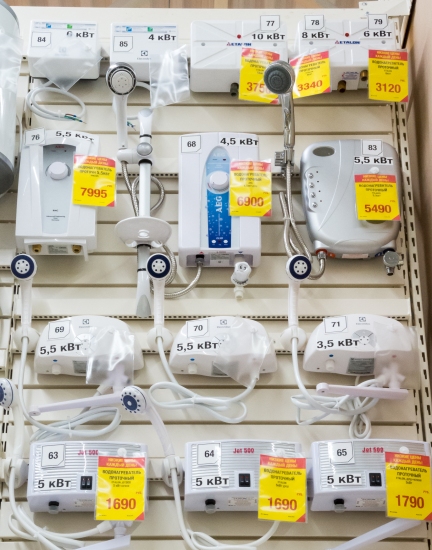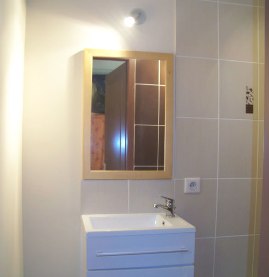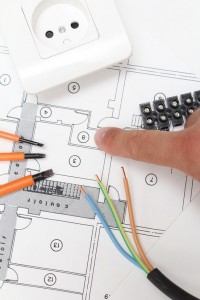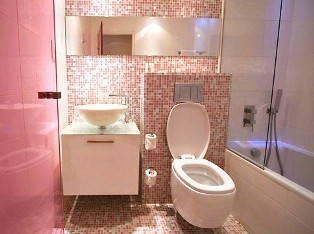Categories: Featured Articles » Electrician at home
Number of views: 18471
Comments on the article: 1
Features of installing electrical wiring and connecting household electrical appliances in the bathroom
 A characteristic feature of the bathroom, in comparison with other rooms of the apartment, is that it has an increased level of humidity, and it is also possible that the elements located on it, including electrics, can splash water onto the wall. Based on this, the installation of electrical wiring in the bathroom is somewhat different from the installation of electrical wiring in other rooms of the apartment. Below, we consider the features of installing electrical wiring and connecting household electrical appliances in the bathroom.
A characteristic feature of the bathroom, in comparison with other rooms of the apartment, is that it has an increased level of humidity, and it is also possible that the elements located on it, including electrics, can splash water onto the wall. Based on this, the installation of electrical wiring in the bathroom is somewhat different from the installation of electrical wiring in other rooms of the apartment. Below, we consider the features of installing electrical wiring and connecting household electrical appliances in the bathroom.
It should be remembered that errors in the installation of electrical wiring in the bathroom, as well as the wrong choice of protective devices, can lead to negative consequences - a person is shocked by electric shock, since electricity and water are incompatible things. Therefore, do not neglect the recommendations and it is better to make the wiring in the bathroom reliable and safe to use.

The main measure of protecting a person from electric shock is the grounding of electrical appliances. Therefore, the electrical wiring in the apartment, including the bathroom, must have a grounding conductor. If you plan to replace the wiring, then it is imperative to provide for the possibility of grounding it.
Many people prefer the installation of a two-wire wiring, arguing their choice with its lower cost. But, safety should be above all, especially in such a dangerous room, like a bathroom, so it is better to spend more money on replacing the wiring, but be sure of your safety.
In addition to grounding, protective shutdown devices must be installed on the electrical wiring lines supplying the bathroom electrical appliances. The residual current device disconnects the wiring line in case of current leakage. For example, if a person accidentally falls under the operating voltage of a household network due to a breakdown in the insulation of the electric heating element of the instantaneous water heater, the protective shutdown device will disconnect this appliance in a split second.

Reliable protection against electric shock is provided only if the residual current device is selected correctly. In addition to the operating threshold of the RCD (differential current), it is necessary to take into account the possible load on the wiring line on which this protective device is installed.
This is necessary in order for the residual current device to work correctly, because it is also designed for a certain rated current. For example, a circuit breaker with a rated current of 16 A is installed on this wiring line. In this case, it is better to choose a residual current device for a higher rated current, since a circuit breaker with such a rated current is able to withstand a large load for some time.
For example, a 16 A circuit breaker can hold a load of 20 A for about an hour. If a current leak occurs during this time, the residual current circuit breaker may not work, as it will operate in overload mode. Many may not agree with this, because in fact the protective shutdown device will work, but if the overloads are long and systematic, then after a while the RCD can fail and if necessary not work.
Read more about RCDs here:About electrical protection devices for "dummies": protective shutdown device
As for protective devices, in addition to the protective shutdown device, it is necessary to install a circuit breaker on each wiring line. The purpose of the circuit breaker is to protect the wiring from damage, therefore, these protective devices must be selected in such a way as to ensure reliable protection of the structural elements of the wiring. For example, to connect an electric water heater, a 16 A outlet is installed, the electrical wiring line is made of a copper wire with a cross section of 2.5 square meters. mm, the power of this appliance is 2000 watts.
To ensure reliable protection of this wiring line from damage, it is necessary to choose a 16 A circuit breaker. But, if more powerful household appliances than a water heater are not included in this outlet, it will be enough to install a 10 A circuit breaker.

If the walls in the bathroom are made of drywall, the cable lines that pass behind the drywall sheets must be additionally protected with a corrugated pipe or laid with a pipe of a different type, since when installing drywall sheets, drilling holes, cable damage can occur.
If both the phase and the neutral conductor are affected, the circuit breaker will open as a result of a short circuit, and you will be able to timely detect that the cable is damaged during drilling. If the integrity of the insulation of one of the conductors is violated, this can lead to negative consequences in the future.
Features of connecting electrical appliances in the bathroom
 In most cases, plug sockets are used to connect household electrical appliances in the bathroom. Based on the fact that the bathroom is a room of high humidity, then an ordinary household power outlet, which is mounted in other rooms of the apartment, will not work. In this case, you must choose a power outlet that has protection against moisture and from accidental splashing of water.
In most cases, plug sockets are used to connect household electrical appliances in the bathroom. Based on the fact that the bathroom is a room of high humidity, then an ordinary household power outlet, which is mounted in other rooms of the apartment, will not work. In this case, you must choose a power outlet that has protection against moisture and from accidental splashing of water.
The degree of protection of the housing from moisture, including from objects, is indicated on the housing of the electrical product in the form of IP marking. As a rule, for the bathroom, a socket outlet is selected, the body of which has IP44 protection and above. This degree of protection provides reliable protection of the outlet from the negative effects of moisture, as well as from splashing water in any direction, which often happens in the bathroom, for example, when taking a shower.
See more about this here: Outlets in the bathroom
It should be noted that when choosing items, you should pay attention to the second digit, since it shows the degree of protection of the housing from moisture. The first figure shows the level of protection of the case from the effects of third-party objects. In everyday life, a second degree of protection is sufficient - protection from fingers and from objects with a diameter of at least 12 mm.
To connect such powerful electrical appliances as a instantaneous water heater, it is not always possible to find a socket that has a large rated current and at the same time has the required protection of the housing from moisture. Therefore, you can use another way - connect the water heater to the cable of the wiring line through the terminal block.
In this case, the installation box is pre-installed, then the terminal strip is installed in it and the necessary conductors (cables) are connected. The mounting box in this case must also have a degree of protection of the housing not lower than IP44. When choosing a terminal block, you should pay attention to its design features, the reliability of the clamps and the correspondence of their load capacity to the actual load of the water heater.
If this is possible, a more acceptable way would be to connect the wiring line to the instantaneous water heater directly, without using a terminal block.The same applies to other electrical appliances that are constantly on the network.
This connection method provides greater reliability, since there are no intermediate contact connections in the form of terminal blocks or receptacles. In addition, the absence of sockets, mounting boxes is an increase in security, since a cable hidden under a layer of plaster is certainly safer than various electrical elements, despite the moisture being sufficiently reliable in their case.
If the connection of electrical appliances is carried out through the terminal strip or directly to the household appliance, it is necessary to provide for the possibility of breaking not only the phase conductor, but also the zero. This possibility is provided by a residual current device installed on this wiring line. If the RCD is installed on several wiring lines, then in order to break the zero and phase conductors in this case, an additional circuit breaker is installed.
If the appliance is disconnected from the network often, for example, in order to save electric energy, the storage water heater (boiler) is periodically disconnected, then it is recommended that the circuit breaker, through which voltage is supplied to this household appliance, be placed in a separate box of the appropriate size, which can be set, for example, below the main distribution panel of the apartment. Firstly, this circuit breaker will be more convenient to turn on, and secondly, there will be no erroneous trips, especially if many switching protective devices are installed in the switchboard.
You should also consider the level of protection against moisture included in the network of household electrical appliances. For example, a storage electric water heater (boiler). At the bottom of this appliance are terminals for connecting a cable or power cord.
Very often, the casing that closes these terminals is loose on the body of the water heater itself, or there are gaps on the casing where the temperature controller is located. Moisture gets into these gaps, which subsequently leads to leakage current. Very often, when operating the water heater, a slight tingling is felt, but the reasons cannot be found. The socket has reliable protection against moisture, the cable insulation is in good condition, but in fact the reason lies in the unreliable protection against moisture in the appliance itself.
In this case, it is necessary to take measures to eliminate gaps and gaps in those parts of electrical appliances where it is necessary to provide reliable protection against moisture by leveling the surfaces, adding additional seals, etc.
See this topic: Why do you need a potential equalization system in the bathroom
See also at bgv.electricianexp.com
:

